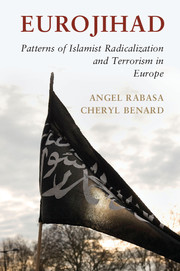Book contents
- Frontmatter
- Contents
- List of figures
- List of tables
- Preface
- Acknowledgments
- List of abbreviations
- 1 Introduction
- 2 Europe’s Muslim Populations
- 3 Salafism and Radical Islamism in Europe
- 4 Origins of Radical Islamist Networks in Europe
- 5 Radicalization Patterns
- 6 Radicalization and Recruitment Nodes
- 7 Evolution of Radical Networks in Europe
- 8 Terrorist Operations and Tactics
- 9 New European Approaches
- 10 Key Judgments
- Bibliography
- Index
- References
5 - Radicalization Patterns
Published online by Cambridge University Press: 05 November 2014
- Frontmatter
- Contents
- List of figures
- List of tables
- Preface
- Acknowledgments
- List of abbreviations
- 1 Introduction
- 2 Europe’s Muslim Populations
- 3 Salafism and Radical Islamism in Europe
- 4 Origins of Radical Islamist Networks in Europe
- 5 Radicalization Patterns
- 6 Radicalization and Recruitment Nodes
- 7 Evolution of Radical Networks in Europe
- 8 Terrorist Operations and Tactics
- 9 New European Approaches
- 10 Key Judgments
- Bibliography
- Index
- References
Summary
Islamist radicalization and recruitment patterns in Europe reflect the ethnic composition of a country’s Muslim population. In a way similar to the Algerians in France who link their violence to the legacy of France’s colonial occupation of Algeria, Britain’s Muslim militants had previously focused their violence on one specific cause: Kashmir. For years, young British Muslim males would travel to Pakistan to take part in the Kashmiri conflict. The specific regional focus on Kashmir and South Asia shifted in the 1990s to include the conflict in Bosnia-Herzegovina as well as other conflicts such as those in Yemen and East Africa, but conflict, nevertheless, remained tied to local causes. That focus has now broadened and converged with al-Qaeda’s global agenda.
Within the broader European Muslims communities, certain populations appear to be more vulnerable than others to radicalization and recruitment into terrorist groups. The population segments that have been particularly susceptible to radicalization and recruitment into violent groups include (1) disaffected second- or third-generation British Muslims of South Asian, largely Pakistani, descent; (2) first- or second-generation North Africans settled on the Continent; (3) converts. Until recently, the Turkish community appeared resistant to radicalization, but there are now signs of incipient radicalization among ethnic Turks born in Europe.
Information
- Type
- Chapter
- Information
- EurojihadPatterns of Islamist Radicalization and Terrorism in Europe, pp. 56 - 102Publisher: Cambridge University PressPrint publication year: 2014
